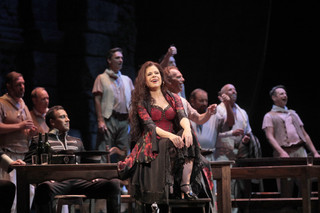|
Back
Blistering Carmen? Los Angeles
Dorothy Chandler Pavilion
09/09/2017 - and September 14*, 17, 20, 23, 28, October 1, 2017
Georges Bizet: Carmen
Ana María Martínez (Carmen), Riccardo Massi*/Brandon Jovanovich (Don José), Amanda Woodbury (Micaëla), Alexander Vinogradov (Escamillo), Liv Redpath (Frasquita), Kelley O’Connor (Mercédès), Brian Michael Moore (Le Remendado), Theo Hoffman (Le Dancaïre), Philip Cokorinos (Zuniga), Juan Carlos Heredia (Moralès), Abdiel Gonzalez (a gypsy), Melissa Treinkman (a vendor), Manuel Gutiérrez Cabello, Oscar Valero (solo dancers)
Los Angeles Opera Chorus and Orchestra, Grant Gershon (chorus director), Anne Tomlinson (artistic director, Los Angeles children’s chorus), Roberto Cani (concertmaster), James Conlon (conductor)
Ron Daniels (stage director), Emilio Sagi (original stage creation), Gerardo Trotti (set designer), Jesús del Pozo (original costume designer), Denitsa Bliznakova (principal costume designer), Duane Schuler (lighting designer), Nuria Castejón (choreographer), Ed Douglas (fight director)

(© Robert Millard)
Like clockwork, Bizet’s perennial favorite returns to Los Angeles Opera as the 2017/2018 season opener. Since its debut in 2004, this Emilio Sagi original creation has revisited The Dorothy Chandler in 2008 and 2013 with politely-altered facelifts to showcase various designers’ vision. Gerardo Trotti’s sets and Jesús del Pozo’s costuming are pretty much staid, save for a few adjustments (i.e. emphasis on black and white wardrobe motif for Carmen and Don José in Act IV and accentuated flamenco dancing dominating the “Prélude” and beginning of Act IV.) [Denitsa Bliznakova’s cuadrilla is anthropologically opulent.]
Many familiar faces grace the stage under Ron Daniel’s vision, though shots of “new blood” add only a sliver of new dimension. After garnering favorable reviews with her Amelia in Simon Boccanegra in 2012, Ana María Martínez unveils her take of the mythological temptress. While the smokiness of her mezzo voice is feathery, she doesn’t elicit enough persuasive feistiness and sultriness (in particular, when she encounters Don José for the first time.) Yet Carmen suddenly shifts with more convincing combativeness in the middle of the “Seguidilla” and the momentum commences though in more urbane fashion. Set against her rôle is Italian Riccardo Massi who builds Don José with caution and careful parlance; Bizet’s music fits comfortably inside his spinto register. Together, their closing arguments (ahead of Carmen’s demise) are palpable and empathetic, especially with Ms. Martínez donning one of Denitsa Bliznakova’s captivating alterations.
Carmen’s varying mood swings require a keen lighting eye which is accommodated under Duane Schuler while the orchestral delivery, rendered under James Conlon, is impeccable: he touches on every delicate nuance and unfurls appropriate flourishes to create atmospheric delight...it doesn’t get any better than this. Such energetic forces also “raise the bar” during the smugglers’ quintet. Liv Redpath’s Frasquita unflinchingly retains all high notes while Kelley O’Connor’s more mellow-voiced Mercédès rounds out the lower end. When adding Brian Michael Moore’s and Theo Hoffman’s Le Remendado and Le Dancaïre, respectively, along with Ana María Martínez, the tune is steeped with splashy vivaciousness.
If one singer stands out from the rest of the cast, it’s Alexander Vinogradov. There’s something unmistakably absorbing in the way he stylizes his Escamillo. This bass makes Carmen move magically. Ensconced with a sexy bravado, M. Vinogradov has the right mix of pomposity in all the right places. Meanwhile, Philip Cokorinos’ Zuniga contributes to the opéra comique mandates via his richly planted bass-baritone register. Amanda Woodbury returns as a determined, though restrained, Micaëla. Her melodic equations add softness and elegance without being syrupy; the “Prière” warmly balances fortitude and humility.
In this year’s turn of Carmen, Ron Daniels places heavier emphasis on story telling through a dance lens, making way for Nuria Castejón. The caffeine-injected stomping is electrifying but at the expense of other peripheral goings-on: sound drowns out Carmen during the “Danse bohémienne”, it pushes the children’s chorus and crowd scene backstage during Act IV’s opening “A deux cuartos.” Blocking inside several group numbers requires re-invention. Flows leading onstage and offstage simply don’t gather credibility, appearing unrealistic and clumsy; cigarette-making women’s character placement [inside Act I] looks too gauzy and trend more towards a Grecian frieze...too much static and not enough action.
Carmen is a proven winner in opera circles, and Los Angeles Opera will turn to Bizet in the years to come. At that juncture, one can hope for new infusions.
Christie Grimstad
|